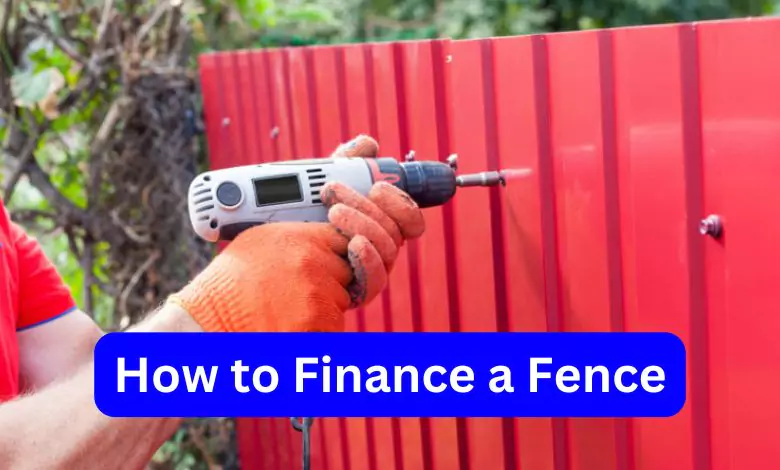How to Finance a Fence: Building a fence can significantly enhance your property’s value, provide privacy, and create a safe environment for your family. However, financing this project can be a concern for many homeowners. In this guide, we will explore various ways to finance a fence, helping you make an informed decision that suits your financial situation.
Understanding the Costs of a Fence
Before diving into financing options, it’s crucial to understand the costs associated with installing a fence. The price can vary widely depending on the materials used, the size of the area to be fenced, and the labor involved. Here’s a breakdown of some common fencing materials:
- Wooden Fences: Typically cost between $15 to $30 per linear foot. While wood is aesthetically pleasing, it requires regular maintenance, which can add to long-term costs.
- Vinyl Fences: These cost around $20 to $40 per linear foot. Vinyl is durable and low-maintenance, making it a popular choice despite its higher upfront cost.
- Chain-Link Fences: One of the most affordable options, ranging from $7 to $20 per linear foot. However, it offers less privacy compared to other materials.
- Wrought Iron Fences: This premium option can cost between $30 to $50 per linear foot. It’s both strong and stylish but comes with a higher price tag.
Additionally, labor costs can vary based on your location, the complexity of the installation, and the contractor’s experience. It’s essential to get multiple quotes to ensure you’re getting the best deal.
1. Home Equity Loan or Line of Credit (HELOC)
One of the most common ways to finance a home improvement project, such as a fence, is through a home equity loan or a home equity line of credit (HELOC). These options allow you to borrow against the equity you’ve built up in your home.
Advantages:
- Lower Interest Rates: These loans typically have lower interest rates compared to personal loans or credit cards because they are secured by your home.
- Tax Deductions: In some cases, the interest on a home equity loan may be tax-deductible if the funds are used for home improvements.
Disadvantages:
- Risk of Foreclosure: Since your home is used as collateral, failure to repay the loan could result in foreclosure.
- Closing Costs: These loans often come with closing costs and fees, which can add to the overall expense.
2. Personal Loans
Another viable option for financing a fence is a personal loan. These loans are unsecured, meaning they don’t require collateral, making them accessible to many homeowners.
Advantages:
- Flexibility: Personal loans can be used for almost any purpose, including fencing projects.
- No Collateral Required: Unlike home equity loans, personal loans don’t require you to use your home as collateral.
Disadvantages:
- Higher Interest Rates: Because personal loans are unsecured, they typically have higher interest rates than secured loans.
- Shorter Repayment Terms: Personal loans usually have shorter repayment terms, which could mean higher monthly payments.
3. Credit Cards
For smaller fencing projects, credit cards may be a convenient financing option. Many homeowners use credit cards to cover the costs, especially if they can pay off the balance quickly.
Advantages:
- Convenience: Credit cards are easy to use and don’t require a lengthy application process.
- Rewards Programs: If your credit card offers rewards or cash back, you could earn benefits while financing your fence.
Disadvantages:
- High Interest Rates: Credit cards often have higher interest rates, which can add significantly to the cost if you don’t pay off the balance promptly.
- Potential Debt: Relying on credit cards for large expenses can lead to high debt levels, which may be difficult to manage.
4. Fencing Company Financing
Many fencing companies offer in-house financing options to make the process more affordable for their customers. This can be an attractive option if you’re looking for a straightforward way to finance your fence.
Advantages:
- Convenience: Financing directly through the fencing company can simplify the process, as everything is handled in one place.
- Promotional Offers: Some companies offer promotional financing, such as 0% interest for a certain period, which can save you money.
Disadvantages:
- Higher Costs: Financing through the fencing company may result in higher overall costs if the interest rates are higher than other financing options.
- Limited Options: You may be limited to using the company’s financing terms, which might not be the best fit for your financial situation.
5. Government Programs and Grants
In some cases, homeowners may be eligible for government programs or grants that provide financial assistance for home improvements, including fencing.
Advantages:
- Low or No Cost: Government grants don’t need to be repaid, making them an attractive option for those who qualify.
- Assistance for Low-Income Homeowners: Some programs are specifically designed to help low-income homeowners make necessary improvements.
Disadvantages:
- Eligibility Requirements: These programs often have strict eligibility criteria, which may limit their availability to certain homeowners.
- Limited Funding: Government grants are usually limited in amount, so they may only cover a portion of the total cost.
Conclusion
Financing a fence doesn’t have to be a daunting task. By understanding the various options available—from home equity loans to credit cards—you can choose the best method that fits your financial situation. Always consider the total cost, interest rates, and repayment terms before making a decision.
Remember, a fence is an investment in your property, offering both practical and aesthetic benefits. With the right financing strategy, you can enhance your home’s value and enjoy the privacy and security a well-built fence provides.

Can you be more specific about the content of your article? After reading it, I still have some doubts. Hope you can help me. https://www.binance.com/es/register?ref=T7KCZASX